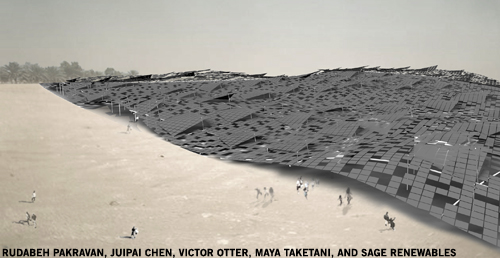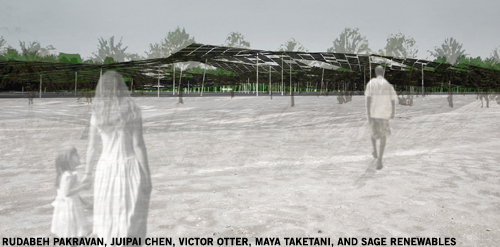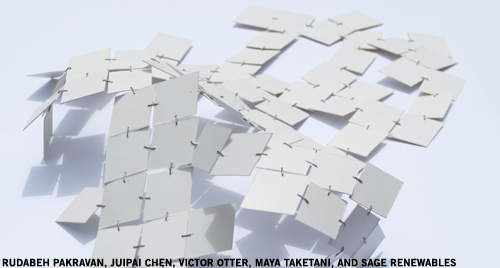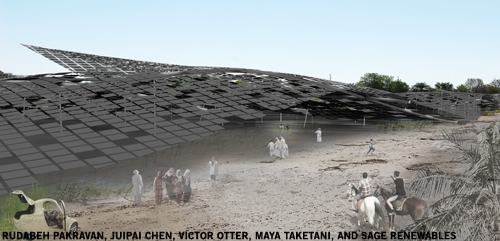Rudabeh Pakravan Studio
Rudabeh Pakravan, Juipai Chen, Victor Otter, Maya Taketani, and Sage Renewables
Designed for Site #3 in Abu Dhabi, on Airport Road near Masdar City.

Design Submission for the 2010 Land Art Generator Initiative Design Competition
Artist’s descriptive text:
Living in the Middle East often involves negotiating the space between your body and the sun. Or between your body and the eye of a neighbor. The veil is a way for you to protect yourself from both of these gazes—a personal sanctuary in the form of a tent or a body covering. The veil itself is functional, but the space it creates within itself becomes infinitely valuable because it is covered.
Solar Veil capitalizes on the availability of a vast swath of land while consecrating it through the idea of the veil. By demarcating that which we consider sacred, whether it is land or body, we claim a responsibility for its cultivation and protection. Veils, curtains, and tents are also temporary; there is an acknowledgement of borrowed space, a desire to leave what we are covering unaltered underneath.

Our proposal covers the site at Airport Road with a porous drape of 300,000 solar units that together have a nameplate capacity of over 16MW of energy. At nearly 175,000 square feet, Solar Veil responds to both the scale of its context and its needs. It becomes a destination in its own right, becoming part of the history of record-breaking infrastructural endeavors in the region while reflecting the vastness of the landscape.
The drape lifts up and touches down on the ground, creating an occupiable and shaded public space. Slits are also cut into the drape and lifted up, catching wind in the direction of its flow and allowing air currents to enter and pass through the space. The wind catchers act in two ways as shown in the diagram above – one, to allow air to pass in and through the space and two, by connecting to an enclosed shaft that pushes the wind underground two meters, where the ground is a constant, cooler temperature. Air returns upward, cooling the space within the drape.

In a region where shaded public space is reserved for parks with entry fees, luxury malls, or on green patches alongside highways, our proposal will create a rare opportunity for people to participate in the public realm, either for recreation or to be a part of a social structure that supports environmental accountability. Situated immediately adjacent to Masdar, the world’s first carbon free city, Solar Veil can both take advantage of the physical infrastructure that is being built there, such as using the proposed monorail to access the site and limit the use of vehicular traffic, and the social network of a sustainable community.
Our proposal attempts to have minimum effect on the site at ground level. The ground remains 80% untouched, with the remaining 20% being excavated for shallow spread footings for the structural system and for the passive cooling tunnels. The site is mostly sparse, but porosity built into the drape system allows for light to reach some areas under the veil that would allow vegetation to remain. The ring of trees around the site remains untouched. At 600gm/square meter, the drape system is very light and needs only a minimal structural armature. We propose a light steel tube framing system that forms a lattice and columns. With the energy generation at a minimum of 16MW, Solar Veil can power 8,000 homes.

Solar panels have already proven to be an extremely effective source of renewable energy. It is no longer necessary to rely on the large and bulkier solar panels traditionally found on roofs or as part of solar farms, but even the most advanced solar cell technology that is available today relies on large, rigid backings and standard sizes to function. In order to create a drape, we are working with a thin film photovoltaic manufacturer to create a small scale unit that is made of photovoltaic laminates overlaid on a 7mm fiberglass panel. The units are 50cm x 50cm and link at the midpoint of each panel to provide flexibility. The units are incredibly light, allowing for attachment to a minimal structural armature. Our proposal ensures that the overall form of the veil allows for 60% of the units to be between 10 to 15 degrees from the horizontal, resulting in maximum solar contact.
Our proposal allows for 20% of energy generated to be stored for off peak use. Wanting a highly efficient storage system with a small footprint, we integrate a group of 12 sodium sulfur (NaS) batteries underneath the surface of the veil.
The surface area of Solar Veil is approximately 160,000 square meters. Even conservatively estimating that only 30% of its area is generating energy, Solar Veil can power 8,000 homes or other buildings in the community. At its peak, it can power twice that.
[…] 8,000 homes or other buildings in the community. At its peak, it can power twice that. Source: Land Art Generator Initiative Reageer […]